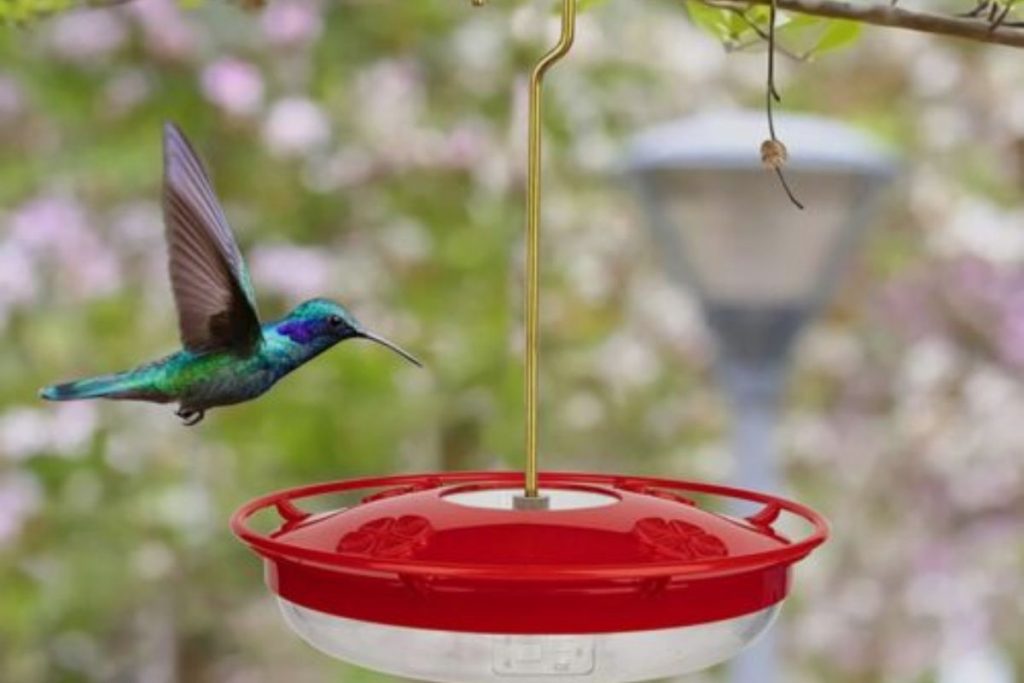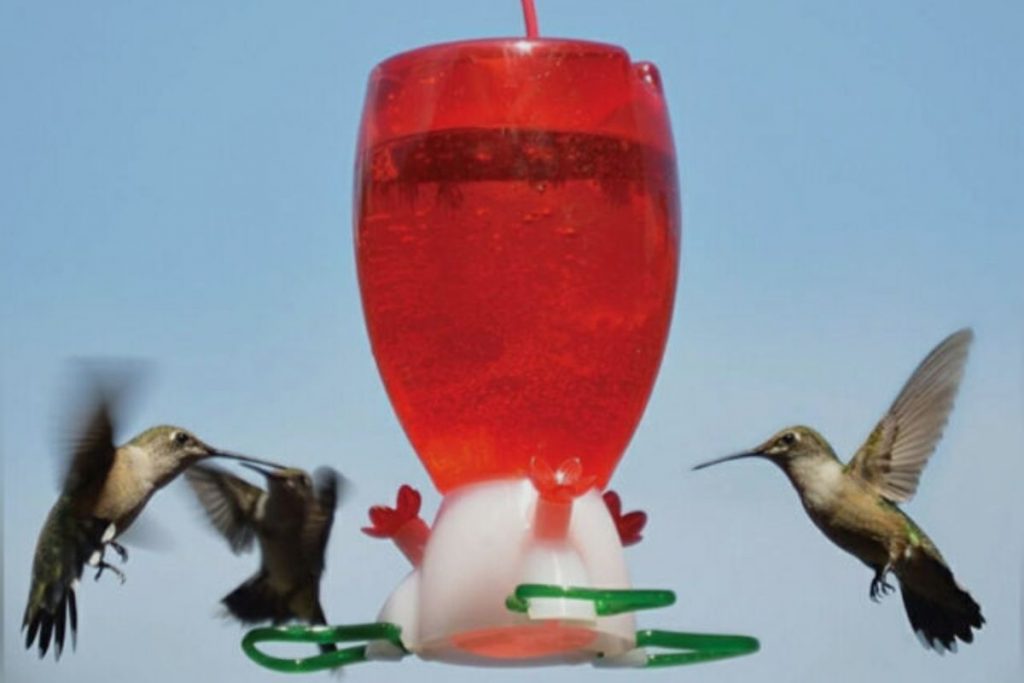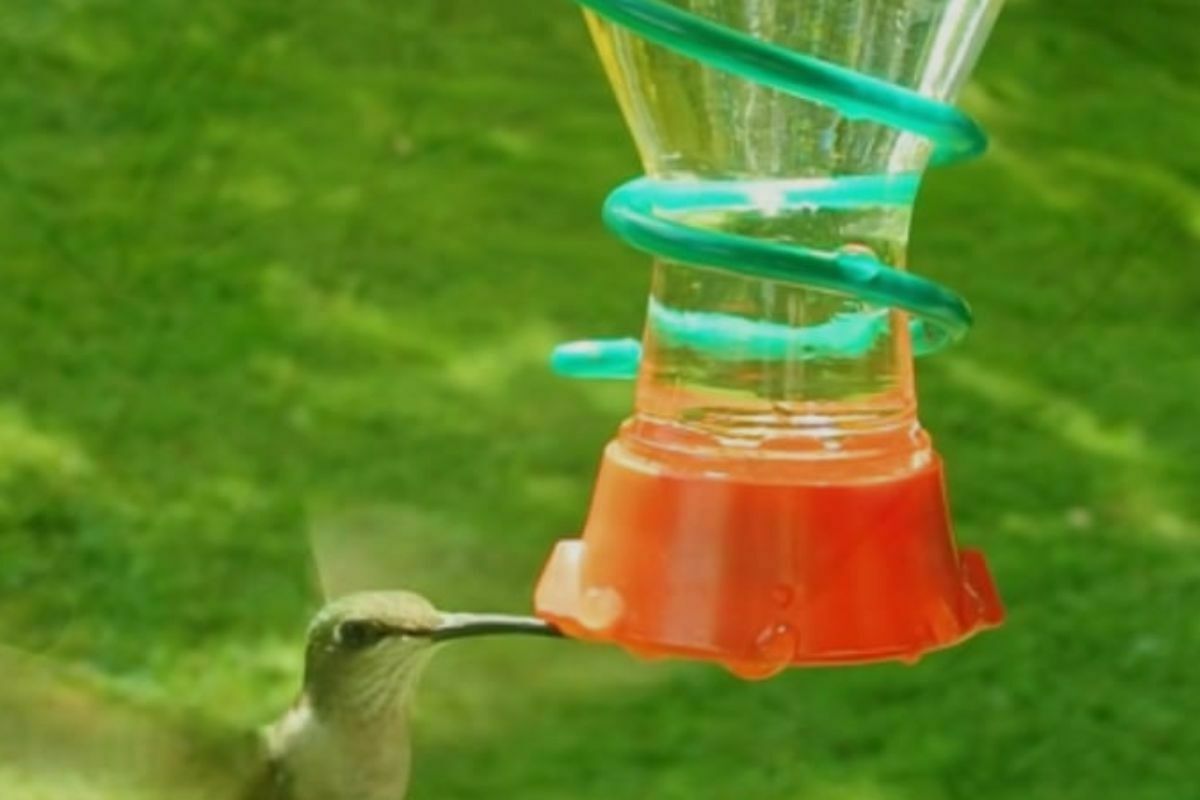Quick Answer: Hummingbird feeders should not be placed in direct sunlight because it causes rapid nectar fermentation and creates potentially harmful conditions for the birds. The best location is in a partially shaded area that provides protection from intense afternoon sun while still being visible to hummingbirds.
Key Takeaways:
- Hummingbird feeders should not be placed in direct sunlight
- Sunlight can cause nectar to ferment within 1-2 hours, making it harmful to hummingbirds
- The ideal placement is in partially shaded areas, particularly under eaves or near protective shrubs.
Related post to read: Best Hummingbird Feeders Compared.
Have you ever wondered if those beautiful glass hummingbird feeders hanging in your garden might actually be harmful when placed in direct sunlight? It’s a common question among bird enthusiasts, and the answer might surprise you. The placement of your hummingbird feeder can make the difference between creating a safe haven for these tiny visitors and unknowingly putting them at risk.
In this blog post, we will explore the science behind proper hummingbird feeder placement, learn about the risks of sun exposure, and discover the best locations for your feeders to keep your tiny visitors healthy and coming back for more.

Why Sunlight and Hummingbird Feeders Don’t Mix
When nectar sits in direct sunlight, several harmful processes begin to occur that can make it dangerous for hummingbirds. Understanding these processes helps us make better choices about feeder placement. When nectar sits in direct sunlight, several harmful processes begin to occur that can make it dangerous for hummingbirds. Understanding these processes helps us make better choices about feeder placement. For instance, the heat can encourage the growth of mold and bacteria, which can be toxic if ingested by these delicate birds. Additionally, the nutritional value of the nectar diminishes over time, making it less beneficial for hummingbirds. Knowing how to optimize feeder locations can help maximize their health and well-being; conversely, many people wonder, ‘do hummingbirds reuse nests,’ as their nesting habits can also play a significant role in their lifecycle and reproductive success. When nectar sits in direct sunlight, it can encourage the growth of harmful bacteria and fungi that could harm the birds. Additionally, the heat can cause the nectar to ferment, leading to potential toxicity. To ensure the safety of our feathered friends, it is crucial to maintain your hummingbird feeder by placing it in a shaded area and regularly cleaning it to prevent these dangers.
The Fermentation Problem
Research from Cornell University’s Lab of Ornithology shows that sugar water in feeders can start fermenting in as little as 1-2 hours when left in direct sunlight. This quick fermentation:
- Creates harmful alcohol compounds that can be dangerous to hummingbirds
- Promotes the growth of harmful bacteria
- Changes the nutritional value of the nectar
- Could prove fatal to hummingbirds if they drink it.
Temperature Concerns
On hot summer days, nectar in sun-exposed feeders can reach temperatures as high as 120°F (48.9°C). This creates two major issues:
- The heat speeds up bacterial growth
- Water evaporates more quickly, changing the sugar concentration.
UV Light Effects
The sun’s ultraviolet rays can damage the nectar by:
- Breaking down important nutrients
- Creating harmful compounds
- Reducing the overall nutritional value.

The Perfect Placement Guide
Instead of placing feeders in full sun, here are the best locations for your hummingbird feeders:
Optimal Locations
- Partially shaded areas
- Eastern exposures (morning sun only)
- Under eaves or overhangs
- Near protective shrubs or trees
- 10-15 feet from protective cover.
Climate-Based Recommendations
Hot Climate Areas
- Choose spots with 75-80% shade coverage
- Set up multiple feeding stations you can rotate
- Use feeders made from UV-resistant materials.
Moderate Climate Regions
- Allow some morning sun (before 10 AM)
- Ensure afternoon shade
- Change positions with the seasons.
Cool Climate Areas
- More sun exposure is acceptable in cooler months
- Keep track of temperature changes
- Make seasonal adjustments as needed.
Choosing the Right Feeder
Different feeder materials handle sun exposure differently:
| Feeder Type | Sun Resistance | Durability | Cost | Maintenance |
|---|---|---|---|---|
| Glass | Excellent | High | High | Easy |
| Plastic | Poor | Low | Low | Moderate |
| Ceramic | Excellent | High | High | Easy |

Glass Feeders
- Resist heat well
- Last longer
- Easy to clean
- Cost more initially.
Plastic Feeders
- Can break down in heat
- Might leak chemicals when hot
- Need replacing more often.
- Cost less to buy
Ceramic Feeders
- Handle heat very well
- Keep nectar temperature steady
- Look attractive
- Might be heavy.
Practical Sun Protection Solutions
Try these methods to protect your feeders:
Natural Protection
- Hang flowering baskets above
- Plant trees strategically
- Grow climbing plants on trellises
- Use garden umbrellas.
DIY Solutions
- Make simple shade covers
- Install removable awnings
- Use movable shepherd’s hooks
- Create adjustable hanging systems.
Essential Care and Monitoring
Daily Checks
- Look at nectar clarity
- Watch for bubbles that show fermentation
- Feel the feeder temperature
- Observe how often hummingbirds visit.
Regular Maintenance
- Clean feeders every 2-3 days in warm weather
- Change nectar before it goes bad
- Deep clean weekly
- Check for damage.
Seasonal Care Guide
Summer Care
- Clean more often
- Provide more shade
- Check nectar daily
- Consider adding extra feeders.
Winter Tips
- Allow more sun exposure
- Use feeders that won’t freeze
- Keep feeding times regular
- Watch for ice.
Safety Signs to Watch
Warning Signs
- Cloudy nectar
- Strong smell
- Visible mould
- Colour changes.
Quick Fixes
- Clean the feeder thoroughly
- Add fresh nectar
- Move to a better spot
- Watch the birds’ behaviour.
Final Thoughts
Proper placement of your hummingbird feeder isn’t just about convenience – it’s about creating a safe and healthy environment for these amazing birds. By following these guidelines, you’ll create the perfect feeding station that keeps hummingbirds coming back throughout the season.
Have you found a creative way to protect your hummingbird feeders from the sun? Share your tips in the comments below!
Frequently Asked Questions (FAQ: Can you a Put Hummingbird Feeder in the Sun?)
Q: How often should I change the nectar in my hummingbird feeder?
A: You should change the nectar every 2-3 days in summer and every 4-5 days in cooler weather. If the feeder is in partial sun, you might need to change it more frequently.
Q: What’s the best time of day to put out fresh nectar?
A: The best time to put out fresh nectar is early morning or late evening when temperatures are cooler and fewer hummingbirds are feeding.
Q: Can I use red dye in my hummingbird nectar?
A: No, red dye is unnecessary and potentially harmful to hummingbirds. The red colour on your feeder is enough to attract them.
Q: How far should feeders be from each other?
A: Place feeders at least 3-4 metres apart to prevent territorial hummingbirds from monopolising all feeding stations.
Q: What’s the ideal height to hang a hummingbird feeder?
A: Hang feeders 1.5 to 2 metres off the ground, ensuring they’re easily visible to hummingbirds but out of reach of cats and other predators. By strategically placing feeders at this height, you can maximize their effectiveness and attract more of these delightful birds to your garden. It’s interesting to note how long hummingbirds locate feeders, often relying on their keen eyesight and memory to find them again. Additionally, consider placing multiple feeders in different locations to create a feeding hotspot that encourages even more visits from these energetic pollinators.
Q: Will placing my feeder in partial shade discourage hummingbirds from visiting?
A: No, hummingbirds will readily visit feeders in partial shade. They actually prefer feeding in areas where they feel protected from predators.
Q: How can I tell if my nectar has gone bad from sun exposure?
A: Look for cloudiness, change in colour, strong fermented smell, or floating particles in the nectar. If you notice any of these signs, replace the nectar immediately.
References:
[Last Updated: January 2025]
